
At present, for titanium alloy welding methods, most people in the industry choose argon arc welding or plasma arc welding for welding processing, but both methods need to be filled with welding materials. Increase, the strength decreases, and the deformation after welding is larger. Electron beam welding and laser beam welding were used to study the welding manufacturability of TC4 titanium alloy, and to complete the fine welding of this material. Next, this article will introduce Titanium alloy welding The methods and precautions are as follows:
(1) Weld porosity tendency. The porosity in the weld is the most common defect in welding titanium alloys, and the hydrogen and oxygen existing in the arc area of the welded metal are the main reasons for the porosity. Electron beam welding of TC4 titanium alloy has few defects of pores in the weld. To this end, the focus is on the process elements that constitute the pores in the laser welding seam.
It can be seen from the experimental results that the pores in the weld seam are closely related to the line energy of the weld seam during laser welding. If the welding line energy is moderate, only a few pores or even no pores are required in the weld seam, and the line energy is too large or too high. Small averages can lead to serious porosity defects in the weld. In addition, whether there is a porosity defect in the weld is also related to the wall thickness of the weldment. Comparing the experimental results of the sample, it can be seen that with the increase of the welding wall thickness, the probability of porosity in the weld will increase.
(2) Internal quality of the weld. Using flat-plate butt samples, electron beam welding and laser welding are used to investigate the internal quality of the weld, and the internal quality of the weld is X-ray inspection, which meets the requirements of GB3233-87 Grade II, and there is no crack on the surface and inside of the weld. , The appearance of the weld is excellent, and the color is normal.
(3) Welding depth and its fluctuation. Titanium alloys are used as engineering components, and there are certain requirements for the welding depth, otherwise the strength requirements of the components cannot be met; and to complete the fine welding, it is necessary to control the fluctuation of the welding depth. For this reason, electron beam welding and laser welding were used to weld two pairs of butt test rings respectively. After welding, the test rings were dissected longitudinally and transversely to investigate the welding depth and the fluctuation of the welding depth. The results showed that the welding seam of electron beam welding was The average welding depth can reach more than 2.70mm, and the fluctuation of welding depth is -5.2~ 6.0%, not exceeding ±10%; the average welding depth of laser welding seam is about 2.70mm, and the fluctuation of welding depth is -3.8~ 5.9%, no Beyond ±10%.
(4) Analysis of joint deformation. The butt test ring is used to investigate the welding deformation of the joint, and the radial and axial deformation of the butt test ring are detected. The results show that the deformation of electron beam welding and laser welding is very small. The radial shortening deformation amount of electron beam welding is f 0.05~f 0.09mm, and the axial shortening amount is 0.06~0.14mm; the radial shortening deformation amount of laser welding is f 0.03~f 0.10mm, and the axial shortening deformation amount is 0.02 ~0.03mm.
(5) Analysis of weld arrangement. According to the management inspection, the weld arrangement is a b, and the arrangement shape is columnar and equiaxed, with a few lath martensite present, the grain size is close to the matrix, the heat-affected zone is narrow, and the arrangement shape and characteristics are ideal.
After discussion, it can be concluded that regarding TC4 titanium alloy, whether it is laser welding or electron beam welding, as long as the process parameters are matched reasonably, the internal quality of the weld can meet the requirements of the national standard GB3233-87 grade II weld, and complete the welding of TC4 titanium alloy. Fine welding; the appearance of the weld is excellent and the color is normal; the weld height is very small, and there are no defects such as undercut, depression, and surface cracks.


 Language
Language  中文简体
中文简体 English
English


 Address:A No.13 Twenty-third Road, South Economic and Technological Development Zone, Shenyang City, Liaoning Province.
Address:A No.13 Twenty-third Road, South Economic and Technological Development Zone, Shenyang City, Liaoning Province. Phone:13898848281
Phone:13898848281 Landline:024-25799905
Landline:024-25799905 Fax:024-25799905
Fax:024-25799905 E-mail:jyjg2018@163.com
E-mail:jyjg2018@163.com